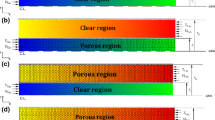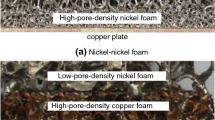Abstract
The problem of enhancing heat transfer to create high thermal performance systems has received a lot of interest, and numerous solutions have been proposed by researchers. To maximize heat transfer, a porous medium was utilized inside the heat exchanger in this research. The study looks into the experimental effects of different porous media layouts as well as the influence of flow rates on heat transfer in various configurations. To investigate the enhancement of heat transmission, porous media with porosity percentages ranging from 96.5 to 98.9% were used. For the air travelling inside the shell, volumetric flow rates of 1 and 3 L per minute were used, with Reynolds numbers ranging from 5000 to 40,000. Nusselt numbers, pressure drops, and efficiency values were calculated in the study. The results show that the volumetric flow rate of the working fluid has no effect on heat transfer or pressure drop in the tested Reynolds number range. Notably, in the examined flow regime, the efficiency of the tube without a porous medium outperforms that of configurations with a porous medium. The results show that in this range of Reynolds numbers, the Nusselt number ratio of the converter with a porous medium to the converter without porosity can vary from a 50% decrease (arrangement number one at Reynolds 5000) to a 200% increase (arrangement number four at Reynolds 30,000), emphasizing the importance of the porous medium arrangement. Furthermore, the influence of porosity on pressure drop can be up to 900 times the dynamic pressure, especially when the porosity covers the entire surroundings, whereas other configurations result in lesser pressure drops.









Similar content being viewed by others
Abbreviations
- A :
-
Heat transfer surface area (m2)
- T :
-
Temperature (K)
- V :
-
Velocity (m s–1)
- Q :
-
Heat transfer rate (W)
- m :
-
Mass flow rate (m3 s–1)
- D :
-
Inner diameter (m)
- L :
-
Length (m)
- Re:
-
Reynolds number
- h :
-
Convective heat transfer coefficient (W m–2 K–1)
- Nu:
-
Nusselt number
- k :
-
Thermal conductivity (W m–2 K–1)
- C :
-
Specific heat capacity (J kg–1 K–1)
- X :
-
Efficiency
- ρ :
-
Density (kg m–3)
- μ :
-
Dynamic viscosity of fluid (Pa s)
- ∆T :
-
Temperature difference (K)
- ∆P :
-
Pressure difference (Pa)
- ɛ :
-
Porosity percentage (%)
- s :
-
Surface
- ave:
-
Average
- air in:
-
Inlet air
- air out:
-
Outlet air
References
Qi C, Luo T, Liu M, Fan F, Yan Y. Experimental study on the flow and heat transfer characteristics of nanofluids in double-tube heat exchangers based on thermal efficiency assessment. Energy Convers Manage. 2019;197: 111877.
Chen T, Wang Y, Qi C, Chen L, Tang Z. Effects of metal foam filling heights and tilt angles on the cooling performance of a heat sink filled with nanofluids. Int Commun Heat Mass Transfer. 2022;138: 106326.
Tu J, Fan F, Qi C, Ding Zi, Liang L. Experimental study on the particle fouling properties of magnetic nanofluids in a corrugated tube with built-in twisted turbulator under variable magnetic field. Powder Technol. 2022;400: 117216.
Wang Y, Jie Yu, Qi C, Zhang W, Liang L. Secondary vortex drag reduction and heat transfer enhancement of nanofluids in hierarchical microchannels applied to thermal management of electronic components. Appl Therm Eng. 2024;236: 121588.
Arasteh H, Mashayekhi R, Toghraie D, Karimipour A, Bahiraei M, Rahbari A. Optimal arrangements of a heat sink partially filled with multilayered porous media employing hybrid nanofluid. J Therm Anal Calorim. 2019;137:1045–58.
Arasteh H, Mashayekhi R, Ghaneifar M, Toghraie D, Afrand M. Heat transfer enhancement in a counter-flow sinusoidal parallel-plate heat exchanger partially filled with porous media using metal foam in the channels’ divergent sections. J Therm Anal Calorim. 2020;141(5):1669–85.
Al-Kouz W, Abderrahmane A, Shamshuddin MD, Younis O, Mohammed S, Anwar Bég O, Toghraie D. Heat transfer and entropy generation analysis of water-Fe3O4/CNT hybrid magnetic nanofluid flow in a trapezoidal wavy enclosure containing porous media with the Galerkin finite element method. The Eur Phys J Plus. 2021;136(11):1–23.
Barnoon P, Toghraie D, Dehkordi RB, Afrand M. Two phase natural convection and thermal radiation of Non-Newtonian nanofluid in a porous cavity considering inclined cavity and size of inside cylinders. Int Commun Heat Mass Transf. 2019;108:104285.
Akbarnataj K, Hamidpour MR, Shirani E, Salimpour MR. Optimization of porous finned heat exchanger configuration using the comprehensive performance methodology. Int Commun Heat Mass Transf. 2022. https://doi.org/10.1016/j.icheatmasstransfer.2022.106318.
Bada A, Khelafi H, Mokhtari AM, Bassoud A, Benhammou M, Menhoudj S. Experimental study of the hygrothermal behavior of an earth/porous pipe/air heat exchanger (EPPAHE) for building cooling needs in the context of the hot and dry Saharan climate. Thermal Sci Eng Prog. 2023;37:101598. https://doi.org/10.1016/j.tsep.2022.101598.
Hendry J, Reay D, Lee J. Computational fluid dynamics modelling of expanded metal porous matrix heat exchangers for intensified carbon capture applications. Therm Sci Eng Prog. 2022;33:101373. https://doi.org/10.1016/j.tsep.2022.101373.
Lin H, Aldawi F, Reda SA, Abdulghani ZR, Asaadi S, Sadighi Dizaji H. Economic cost and thermal efficiency analysis of porous-minichannel heat exchanger for thermoelectric generator. Appl Ther Eng. 2022;213:11. https://doi.org/10.1016/j.applthermaleng.2022.118653.
Mona Y, Do TA, Pothaya S, Wongnor S. The effect of porous media on a solar thermoelectric energy harvesting system. Energy Rep. 2021;7:493–8.
Choi Y, Negash A, Kim TY. Waste heat recovery of diesel engine using porous medium-assisted thermoelectric generator equipped with customized thermoelectric modules. Energy Convers Manage. 2019;197: 111902.
Ghasemi K, Mahmud S, Tasnim S. Optimization of microencapsulated phase change material slurry-based porous heat exchanger. J Energy Stor. 2022;55:105797. https://doi.org/10.1016/j.est.2022.105797.
Huu-Quan D, Memarian A, Izadi M, Shehzad SA. Thermal performance and effectiveness of a dual-porous domestic heat exchanger for building heating application. Renew Energy. 2020;162:1874–89. https://doi.org/10.1016/j.renene.2020.09.134.
Li X, Wilson CT, Zhang L, Bhatia B, Zhao L, Leroy A, Brandt O, Orta-Guerra R, Youngblood JP, Trice RW, Wang EN. Design and modeling of a multiscale porous ceramic heat exchanger for high temperature applications with ultrahigh power density. Int J Heat Mass Transf. 2022;194:122996. https://doi.org/10.1016/j.ijheatmasstransfer.2022.122996.
Chen D, Riaz A, Aute VC, Radermacher R. A solid–liquid model based on lattice Boltzmann method for phase change material melting with porous media in cylindrical heat exchangers. Appl Ther Eng. 2022;207:118080. https://doi.org/10.1016/j.applthermaleng.2022.118080.
Bahoosh Kazerooni R, Kazemzadeh Hannani S. Simulation of turbulent flow through porous media employing a v2f model. Trans B: Mech Eng. 2009;16(2):159–67. https://doi.org/10.1063/1.2835977.
Author information
Authors and Affiliations
Corresponding author
Additional information
Publisher's Note
Springer Nature remains neutral with regard to jurisdictional claims in published maps and institutional affiliations.
Rights and permissions
Springer Nature or its licensor (e.g. a society or other partner) holds exclusive rights to this article under a publishing agreement with the author(s) or other rightsholder(s); author self-archiving of the accepted manuscript version of this article is solely governed by the terms of such publishing agreement and applicable law.
About this article
Cite this article
Tavakoli, M., Hojaji, M., Soufivand, M.R. et al. Presence of a porous medium and the arrangements effects on the performance of an air-cooled heat exchanger: an experimental study for heat transfer and pressure drop. J Therm Anal Calorim (2024). https://doi.org/10.1007/s10973-024-13234-0
Received:
Accepted:
Published:
DOI: https://doi.org/10.1007/s10973-024-13234-0




